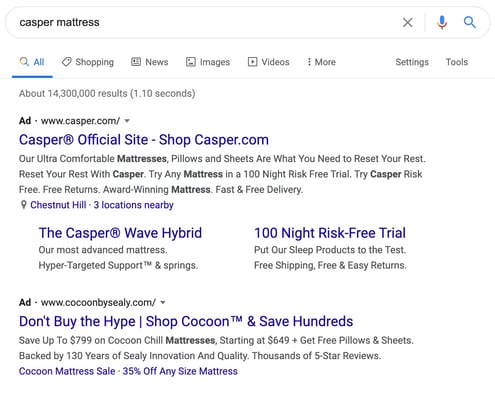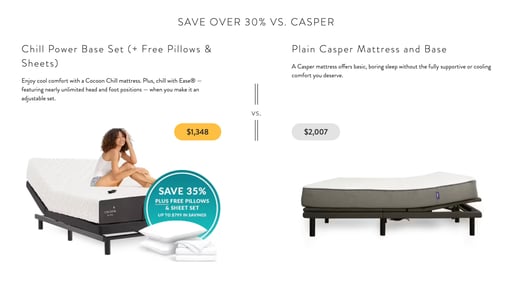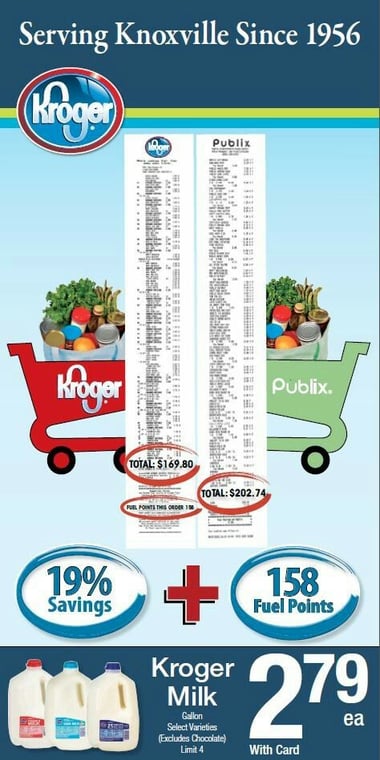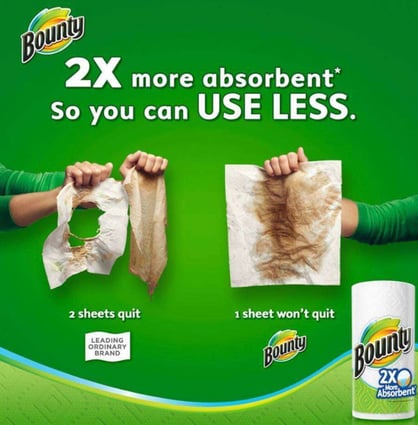- Like
- SHARE
- Digg
- Del
- Tumblr
- VKontakte
- Flattr
- Buffer
- Love This
- Save
- Odnoklassniki
- Meneame
- Blogger
- Amazon
- Yahoo Mail
- Gmail
- AOL
- Newsvine
- HackerNews
- Evernote
- MySpace
- Mail.ru
- Viadeo
- Line
- Comments
- Yummly
- SMS
- Viber
- Telegram
- JOIN
- Skype
- Facebook Messenger
- Kakao
- LiveJournal
- Yammer
- Edgar
- Fintel
- Mix
- Instapaper
- Copy Link
Advertising is the process of creating messages that raise awareness of your brand.
These messages can have various purposes like attracting potential customers, promoting upcoming sales, and introducing new products to market. Most advertisements center around one business, but a unique type, called comparative advertising, centers around two.
When done right, comparative ads can successfully convince consumers to do business with one brand over another. But, when done wrong, companies may find themselves in the middle of a lawsuit. Given this, using comparative advertising requires care and attention.
In this post, we’ll explain what comparative advertising is, give examples from real-life businesses, explain the legality of using the strategy, and present pros and cons that you can use to make the best decision for your business.
What is comparative advertising?
Comparative advertising is a technique that involves presenting a product or service from your business as being superior to a similar product or service from a competitor.
These ads can directly or indirectly mention a competitor, but consumers can typically deduce who the other business is through product features and call-outs. Comparative ads also give customers a direct point of comparison between two companies, as they can view products and assess features all at once, rather than needing to seek out information from multiple sources.
Although they may feature two businesses, it is important to note that one company creates the ad for their benefit, so its tone is swayed in their favor. That being said, businesses aren’t allowed to make false claims about their competitors, so consumers are presented with factual information.
There is no set template for comparative advertisements; they can be digital or print, videos or images, humorous or serious. Many businesses take advantage of 21st-century viral culture and share ads on social media platforms and capitalize on the traffic from likes, retweets, follows, and shares.
Comparative Advertising Examples
Below we’ll go over some real-life examples of comparative advertising to help you understand the practice.
Popeyes
Popeyes is an American fast-food chain that serves fried chicken. Chick-fil-A is their direct industry competitor, well known for being closed on Sundays.
Popeyes capitalized on this and created a comparative advertisement that emphasized that their restaurant is open on Sundays, ready and able to serve consumers every day of the week, especially while Chick-fil-A takes a day off. The video is shown below.
Sprint
Verizon, a cellular provider, used the same actor as the face of their commercials for nine years. Sprint, an industry competitor, poached the actor in 2016 and used his switch to their service to take a unique approach to comparative advertising.
In the video below, Sprint essentially says, if a long-time, loyal Verizon actor can switch to Sprint, why can’t you change as well? The business positions itself as a qualified competitor by saying that their cell phone service has a 1% difference in coverage than Verizon.
Cocoon by Sealy
Casper is a well-known mattress brand that has managed to garner significant hype and recognizability for its products.
Cocoon by Sealy, a direct competitor, uses comparative advertising in search engine result pages (SERPs) to target Casper’s intended audience. The company placed a paid ad in a SERP for the term Casper mattress (shown below), with the headline “Don’t Buy the Hype, Shop Cocoon & Save Hundreds.”

Cocoon claims that its competitor is only a competitor because people buy for the name-brand hype. If a curious consumer clicks on the ad, they learn that Cocoon offers mattresses that are worthwhile because they are conducive to peaceful sleep and are affordable (displayed in the image below).

Adidas
Adidas is a well-known sports apparel brand that is only outshined by Nike. Adidas created a comparative video (shown below) that features a person running in the desert wearing Nike shoes.
Runners know outdoor terrains are challenging to run in. Still, the most impressive thing in the video is that the cameraman carrying a 50-pound camera can keep up with the runner because he’s wearing Adidas shoes.
Kroger
Kroger is a grocery store chain that took out a full-page comparative advertisement against a local competitor (Publix) in a Tennessee newspaper.
The advertisement, shown in the image below, features two long receipts from both stores that are the same length, but costs were cheaper, and savings were higher at Kroger. The brand essentially says that, even if you buy the same products, Kroger offers lower prices, savings, and additional perks that consumers cannot find at Publix.

Bounty
Bounty is a paper towel brand that created a comparative ad to display the benefits of using their paper towels versus the leading generic brand. While they don’t explicitly name a competitor, they make a dig at whoever it may be by calling them the “ordinary brand” because they can’t clean up messes as well as Bounty can.
Essentially, they’re saying Bounty is premium, and any other option is just regular.

While all of these businesses used comparative advertising, it’s essential to understand that it’s only that — comparative. Each company believes it is the best option, but they say that through comparison, not false or misleading claims.
However, given that the line can be vague, many countries have laws that dictate how comparative ads can and can’t be used.
Comparative Advertising Law
Below, we’ll discuss the comparative advertising laws from three different countries and the explicit language they use to explain what advertisers are allowed to do.
United States Comparative Advertising Law
The U.S.’s Federal Trade Commission (FTC) protects consumers from being deceived, defrauded, and manipulated by businesses. It also protects companies from unfair practices and activities of competitors.
The FTC ruled on comparative advertising and said, “Comparative advertising, when truthful and nondeceptive, is a source of important information to consumers and assists them in making rational purchase decisions. Comparative advertising encourages product improvement and innovation, and can lead to lower prices in the marketplace.”
In brief, the FTC supports comparative advertising, as it benefits consumers by giving a well-rounded view of product offerings. What they don’t tolerate is advertising that disparages competitors and is deceptive as a means to get consumers to do business with one company over another. Companies can use the FTC ruling to file claims if they feel as though they are being discredited.
Australia Comparative Advertising Law
The Australian Competition and Consumer Commission says that “Businesses may use comparative advertising to directly promote the superiority of their products over another.” Like U.S. law, businesses must follow general advertising best-practices of not being deceptive or misleading in an attempt to entice consumers to do business with them.
Hong Kong Comparative Advertising Law
Hong Kong has no specific legislation intended to limit comparative advertising. Still, the Trade Descriptions Ordinance prohibits false trade descriptions and misleading or incomplete information advertisements, and the Association of Accredited Advertising Agencies of Hong Kong has the authority to investigate instances of violation.
All in all, regardless of your location, it’s important to understand the laws and regulations of comparative advertisements, so you don’t find yourself in the middle of a lawsuit.
Comparative Advertising Pros and Cons
The reality of choosing to use comparative advertising is up to your individual business needs.
Suppose you have an industry competitor that owns most of the market share. In that case, comparative advertising can be beneficial as you’re letting your target market know that there are other options out there. If you’re a new business, comparative advertising can also help generate awareness around the fact that you exist.
However, if you’re unable to support your claims of superiority and your advertisements seem more berating than comparative, you can stand to lose business. Overall, as mentioned above, the decision to use comparative advertising depends on your goals.
We’ve compiled a list of comparative advertising pros and cons that will help you make a comprehensive decision about whether you should opt to use the strategy.
Pros | Cons |
Explicit product emphasis. Comparative advertising specifically focuses on a single product or feature that makes you better than a competitor, which is helpful advertising for your products in general. Even if you don’t sway your audience, they are still becoming aware of its direct specifications, benefits, and features. | You can face legal action. As mentioned above, many countries have laws protecting consumers and other businesses from comparative ads. If you don’t follow legal requirements, you may face legal action from your competitors that requires significant legal fees. If you’re a big name brand, publications will likely report on it, which can also negatively impact your reputation. |
Raise awareness. Comparative marketing can help you raise awareness for your business, especially if you’re new to the industry or a small business standing up to a competitor. Mentioning their name gives you exposure to their market share and an entirely new audience that may be ready to make the switch. | Can create brand name confusion. Just as comparative ads can generate brand awareness, they can also spur confusion. Mentions of multiple competitors in the same ad can lead consumers to become confused about which business offers the features they prefer or which company proved to be the best option to meet their needs. |
Gain new followers and attract new clients. Comparative advertising can help you gain new followers and attract new clients, primarily when these ads are widely distributed and placed in high-volume consumer traffic areas. For example, many businesses in the United States create humorous comparative advertisements to share during the Super Bowl because they know the event has significant viewership. | You may lose integrity and look bad to your audience. Suppose your advertisements don’t align with your countries comparative advertising rules and are flat-out disparaging of your competitors. In that case, you may look bad to your target audience, which is the opposite effect you’re trying to have. In addition, even if you follow the laws, some people just don’t appreciate ads that pit two companies against each other. It’s best to first understand your target audience before electing to create and share comparative advertisements. |
Inform consumers about what is important. As comparative ads focus on a specific feature or experience that comes with a product or service, you’re informing consumers about the factors they should keep in mind when making purchasing decisions. Essentially, you’re showing them that they should consider more than just the brand name of the product they’re interested in. |
Comparative Advertising Can Help Your Business Grow
Should you opt to use it as part of your business’ marketing strategy, be mindful of comparative advertising laws in your country, ensure that you’re providing benefit to the consumer, and that you’re not simply disparaging your competitor and claiming superiority.
If done successfully, you can stand to raise significant brand awareness, drive revenue, and even capture a higher portion of your industry market share and position yourself as an industry leader.
Originally published Mar 30, 2021 7:00:00 AM, updated March 30 2021
![what-is-comparative-advertising?-[+-examples]](https://everythingflex.com/wp-content/uploads/2021/03/8159-what-is-comparative-advertising-examples.jpg-23keepProtocol)



